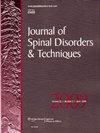在统计学之外,“倒退”这个词意味着倒退。为什么回归是一个有价值的统计工具?
Q Medicine
引用次数: 1
摘要
回归模型目前在脊柱研究中被广泛使用,它们可以用来解释或预测结果。回归模型可以表明每个变量对预期结果的相对影响,因此当模型被开发出来时,它可以用来预测假设患者的结果。本文章由计算机程序翻译,如有差异,请以英文原文为准。
Outside of Statistics, the Word "Regress" Means Going Backward. So Why Is Regression Such a Valued Statistical Tool?
Regression models are commonly used in spine research today, and they can be used to explain or predict an outcome. A regression model can indicate the relative impact of each variable on the expected outcome, so when the model has been developed, it can be used to predict the outcome for a hypothetical patient.
求助全文
通过发布文献求助,成功后即可免费获取论文全文。
去求助
来源期刊
CiteScore
2.16
自引率
0.00%
发文量
0
审稿时长
3 months
期刊介绍:
Journal of Spinal Disorders & Techniques features peer-reviewed original articles on diagnosis, management, and surgery for spinal problems. Topics include degenerative disorders, spinal trauma, diagnostic anesthetic blocks, metastatic tumor spinal replacements, management of pain syndromes, and the use of imaging techniques in evaluating lumbar spine disorder. The journal also presents thoroughly documented case reports.

 求助内容:
求助内容: 应助结果提醒方式:
应助结果提醒方式:


